

Cihan
Lyon IAE B2B EIS Workshop Session Main Presentation Part 1. EIS Simulation - Insights & Models by José PIETRI on Prezi. Change management 5. Change management. The Basics of Working on Teams. What is a team?
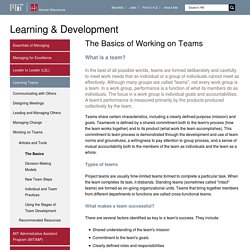
In the best of all possible worlds, teams are formed deliberately and carefully to meet work needs that an individual or a group of individuals cannot meet as effectively. Although many groups are called "teams", not every work group is a team. In a work group, performance is a function of what its members do as individuals. The focus in a work group is individual goals and accountabilities. A team's performance is measured primarily by the products produced collectively by the team. Teams share certain characteristics, including a clearly defined purpose (mission) and goals. Types of teams. Push & pull marketing strategies. Promotional strategies to get your product or service to market can be roughly divided into two separate camps. 1.
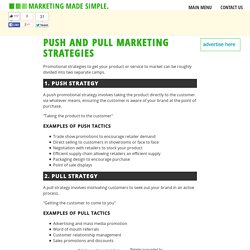
Push strategy A push promotional strategy involves taking the product directly to the customer via whatever means, ensuring the customer is aware of your brand at the point of purchase. Funny Quotes Change Management 2. How to develop a sales strategy for your businesses. How to Sell Services More Profitably. Manufacturers frequently believe that adding value in the form of services will provide a competitive advantage after their products start to become commodities.

When the strategy works, the payoffs are impressive, and a company may even discover that its new service business makes more money than its products. But for every success story, at least five cautionary tales remind us that manufacturing companies will most likely struggle to turn a profit from their service businesses. Even the best stumble. Consider one large technology firm we studied—a world leader in medical equipment, IT, automotive equipment, and transportation systems. Back in 2003 the company’s €5 billion IT business unit realized that the limited product-related services it offered, such as installation and training, generated twice the 3% to 4% net margins it earned on its increasingly commoditized product offerings. ContentServer. APWUUYmZIZ. The psychology of change management. Over the past 15 or so years, programs to improve corporate organizational performance have become increasingly common.
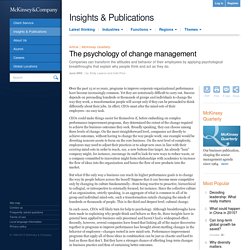
Yet they are notoriously difficult to carry out. Success depends on persuading hundreds or thousands of groups and individuals to change the way they work, a transformation people will accept only if they can be persuaded to think differently about their jobs. In effect, CEOs must alter the mind-sets of their employees—no easy task. CEOs could make things easier for themselves if, before embarking on complex performance-improvement programs, they determined the extent of the change required to achieve the business outcomes they seek.
Broadly speaking, they can choose among three levels of change. 10 Principles of Change Management. Updated: 10 Principles of Leading Change Management This classic guide to organizational change management best practices has been updated for the current business environment.

To read the newest article, click here. Or, to watch a related video, click on the play button above. Way back when (pick your date), senior executives in large companies had a simple goal for themselves and their organizations: stability. Shareholders wanted little more than predictable earnings growth. Market transparency, labor mobility, global capital flows, and instantaneous communications have blown that comfortable scenario to smithereens. This presents most senior executives with an unfamiliar challenge. Managing Organizational Change - Encyclopedia - Business Terms. Related Terms: Organizational Growth Organizational change occurs when a company makes a transition from its current state to some desired future state.
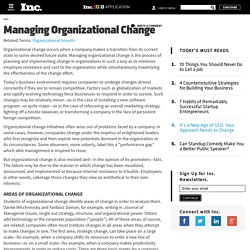
Managing organizational change is the process of planning and implementing change in organizations in such a way as to minimize employee resistance and cost to the organization while simultaneously maximizing the effectiveness of the change effort. Today's business environment requires companies to undergo changes almost constantly if they are to remain competitive. Change Management - Change Management Training from MindTools.com. Making Organization Change Happen Effectively.
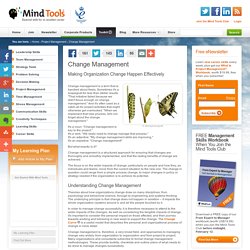
Service Marketing mix - 7 P's (Booms and Bitner) - ToolsHero. More and more organizations are competing one another strategically to distinguish themselves in the area of service and quality within a market.
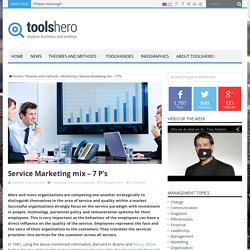
Successful organizations strongly focus on the service paradigm with investment in people, technology, personnel policy and remuneration systems for their employees. This is very important as the behaviour of the employees can have a direct influence on the quality of the service. Employees represent the face and the voice of their organization to the customers. They translate the services provision into services for the customer across all sectors.
In 1981, using the above mentioned information, Bernard H. The traditional marketingmix (4 P’s) The four basic elements from the concept marketing mix that have been devised by the American marketing professor Jerome McCarthy are: SMP / Société suisse de Management de Projet. AlphaLabs: La Simulation EIS. La Simulation EIS® a été conçue pour développer les compétences de ceux qui doivent conduire le changement dans l’entreprise et pour motiver tous ceux qui participent au processus.

Ludique et flexible, la Simulation EIS® associe des technologies informatiques de pointe aux dernières avancées en matière de pédagogie et de gestion du changement. Qu’est-ce que c’est ? Une nouvelle façon d’apprendre à conduire le changement. La simulation EIS® est un logiciel d’apprentissage multimédia qui permet aux participants simuler un changement d’importance dans une organisation et de se confronter à différentes formes de résistance.
Pour qui ? Un outil adapté à un large éventail d’organisations, de situations et de publics.